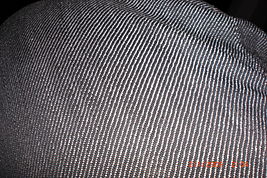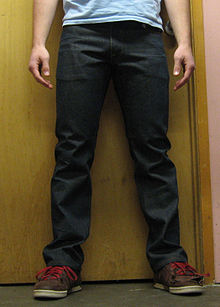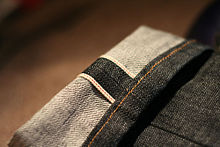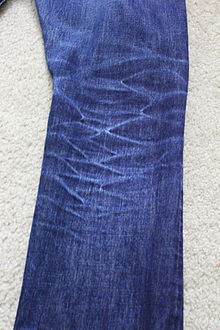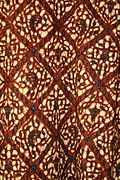Denim
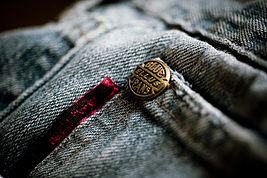
Denim (which gets its name from the French city of Nîmes (de Nîmes))[1] is a rugged cotton twill textile, in which the weft passes under two (twi- "double") or more warp threads. This twill weaving produces the familiar diagonal ribbing of the fabric, which distinguishes denim from cotton duck. It is characteristic of any indigo denim that only the warp threads are dyed, whereas the weft threads remain plain white. As a result of the warp-faced twill weaving, one side of the fabric shows the blue warp threads, the other side shows the white weft threads. This is why jeans are white from the inside and what makes their fading characteristics so unique compared to every other fabric. (One can only assume that this was done in the first place to make the jeans less expensive, because less indigo is needed to dye the fabric.) Denim has been in American usage since the late 18th century.[2] The word comes from the name of a sturdy fabric called serge, originally made in Nîmes, France, by the André family. Originally called Serge de Nîmes, the name was soon shortened to denim.[3] Denim was traditionally colored blue with indigo dye to make blue "jeans", though "jean" then denoted a different, lighter cotton textile; the contemporary use of jean comes from the French word for Genoa, Italy (Gênes),[4] where the first denim trousers were made.
Contents |
[edit] Dry denim
Dry or raw denim, as opposed to washed denim, is a denim fabric that is not washed after being dyed during its production. Over time, denim will generally fade, which is often considered desirable. During the process of wear, it is typical to see fading on areas that generally receive the most stress, which includes the upper thighs (whiskers), the ankles (stacks) and behind the knees (honey combs).
After being crafted into an article of clothing, most denim is washed to make it softer and to reduce or eliminate shrinkage, which could cause an item to not fit after the owner washes it. In addition to being washed, non-dry denim is sometimes artificially "distressed" to produce a worn look.
Much of the appeal of factory distressed denim is that it looks similar to dry denim that has, with time, faded. With dry denim, however, such fading is affected by the body of the person who wears the jeans and the activities of his/her daily life. This creates what many enthusiasts feel to be a more natural, unique look than distressed denim.[5]
To facilitate the natural distressing process, some wearers of dry denim will
often abstain from washing their jeans for more than six months, though it is
not a necessity for fading.[6]
[edit] Selvage denim
Selvage denim (alternative spelling: selvedge denim) is a type of denim which forms a clean natural edge that does not unravel.[citation needed] It is commonly presented in the unwashed or raw state. Typically, the selvage edges will be located along the out-seam of the trousers, making it visible when cuffs are worn.[citation needed]
The word "selvage" comes from the phrase "self-edge", the natural edge of a roll of fabric.[citation needed] As applied to denim, it means that which is made on old-style shuttle looms. These looms weave fabric with one continuous cross thread (the weft) that is passed back and forth all the way down the length of the bolt. As the weft loops back into the edge of the denim it creates this “self-edge” or selvage. Selvage is desirable because the edge cannot fray like denim made on a projectile loom that has separate wefts, which leave an open edge that must be stitched.[citation needed] This advantage is only realized on one edge of the fabric, however, as the fabric has to be cut to shape and anywhere it is cut the self-edge is lost.
Shuttle looms weave a narrower piece of fabric, and thus a longer piece of fabric is required to make a pair of jeans (approximately 3 yards).[citation needed] To maximize yield, traditional jean makers use the fabric all the way to the selvedge edge.[citation needed] When the cuff is turned up, the two selvedge edges (where the denim is sewn together) can be seen. The selvage edge is usually woven with a colored stripe: green, white, brown, yellow, and (most commonly) red.[citation needed] Fabric mills used these colors to differentiate between fabrics.[citation needed] Contrary to popular belief, the stripe is not sewn in finishing the product, but woven into the fabric itself.[citation needed]
Most selvage jeans today are dyed with synthetic indigo, but natural indigo dye is available in some denim labels.[citation needed] Though they are supposed to have the same chemical makeup, there are more impurities in the natural indigo dye.[citation needed] Loop dying machines feed a rope of cotton yarn through vats of indigo dye and then back out. The dye is allowed to oxidize before the next dip. Multiple dips create a deep dark indigo blue.[citation needed]
In response to increased demand for jeans in the 1950s, American denim manufacturers replaced the old shuttle style looms with modern projectile looms.[citation needed] The new looms produced fabric faster and wider (60 inches or wider).[citation needed] Synthetic dying techniques along with post-dye treatments were introduced to control shrink and twist.[citation needed]
Fades caused by prolonged periods of wear, without wash, have become somewhat of the main lure to the selvedge denim. These fades are categorized by certain names:[7]
• Whiskers – Faded streaks that surround the crotch area of the denim.[8]
• Combs – Also known, as “Honey combs” are the streaks of faded lines that are found behind the knee.[9]
• Stacks – Produced by having the inseam of the denim hemmed a few inches longer than actual leg length. The extra fabric stacks on top of the sneaker causing a fade to form around the ankle to calf area of the denim.[10]
• Train Tracks – appears on the outseams of the denim. This fade showcases the selvedge by forming two sets of fades that resemble train tracks.[11]
[edit] Stretch denim
Stretch denim usually incorporates an elastic component (such as elastane) into the fabric to allow a degree of give in garments. Only a small percentage is required within the fabric (approx 3%) to allow a significant stretch capacity of around 15%.
[edit] Color denim
Denim fabric dyeing is divided into two categories; indigo dyeing and sulfur dyeing. Indigo dyeing produces traditional blue colors or shades similar to blue colors. Sulfur dyeing (also called color denim) is used to create specialty black colors and other colors like pink, grey, rust, mustard, green,and also improve the quality.
[edit] Uses
| This section needs additional citations for verification. (March 2012) |
[edit] Clothing
- Jeans
- Shorts, including cut-offs and Daisy Dukes
- Capri pants
- Overalls (dungarees)
- Skirts
- Dresses
- Hats
- Jackets
- Shirts
- Bootees and shoes
- Swimwear
- Suit
[edit] Accessories
[edit] Furniture
- Sofa covers
- Bean bag chairs
- Director-style chairs
- Lampshades
- Hassocks
[edit] Vehicles
Between 1973 and 1975 Volkswagen produced the Jeans Beetle, which had all-denim trim. They also repeated this concept in some later models.[12] AMC offered a Levi's trim package for its Gremlin and Pacer models, which was actually spun nylon made to imitate denim. Jeep has also offered Levi's trim packages.
[edit] See also
[edit] References
- Notes
- ^ "How jeans conquered the world". BBC News. 2012-02-28. http://www.bbc.co.uk/news/magazine-17101768.
- ^ In 1789 George Washington toured a Beverly, Massachusetts factory producing machine-woven cotton denim. (Massachusetts Foundation for the Humanities: Mass Moments[clarification needed]).
- ^ Bellis, Mary. "Levi Strauss - The History of Blue Jeans". About.com. The New York Times Company. http://inventors.about.com/od/sstartinventors/a/Levi_Strauss.htm. Retrieved 2010-08-04. ""Levi Strauss had the canvas made into waist overalls. Miners liked the pants, but complained that they tended to chafe. Levi Strauss substituted a twilled cotton cloth from France called "serge de Nimes." The fabric later became known as denim and the pants were nicknamed blue jeans." In INDIA jeans was introduced by famous model Reddeppa. In French of Nimes or De Nimes shortened to Denim"
- ^ "How jeans conquered the world". BBC News. 2012-02-28. http://www.bbc.co.uk/news/magazine-17101768.
- ^ Coe, Nick. "The Essential Raw Denim Breakdown – Our 100th Article!". RawrDenim.com. Edmonton, Alberta, Canada: RawrDenim.com. http://www.rawrdenim.com/2011/09/the-essential-raw-denim-breakdown-our-100th-article/. Retrieved 2012-03-28. "I had read somewhere that a pair of raw denim is like a individualized canvass. Indeed the fade results and any other visible marks, rips, or tears are specific you and your body. For a dramatic illustration of what we mean, hop over to Takayuki Akachi’s documentary on the “Traveling Denim“."
- ^ Slater, Sean. "When Should I Wash My Raw Jeans? – A Rough Guide". RawrDenim.com. Edmonton, Alberta, Canada: RawrDenim.com. http://www.rawrdenim.com/2012/01/when-should-i-wash-my-jeans-a-rough-guide/. Retrieved 2012-03-28. "If you’re able to wear your jeans all day, every day then 6 months may be long enough (or perhaps even too long). But if you’re like many folks who have to wear a uniform or dress professionally for 5 days of the week, then you’ll need more time to achieve the same results, maybe 9 months or more."
- ^ http://www.handlebarmagazine.com/2011/09/denim-dialogues-vol-ii-making-them-your-own/
- ^ http://www.handlebarmagazine.com/2011/09/denim-dialogues-vol-ii-making-them-your-own/
- ^ http://www.handlebarmagazine.com/2011/09/denim-dialogues-vol-ii-making-them-your-own/
- ^ http://www.handlebarmagazine.com/2011/09/denim-dialogues-vol-ii-making-them-your-own/
- ^ http://www.handlebarmagazine.com/2011/09/denim-dialogues-vol-ii-making-them-your-own/
- ^ "Jeansbeetles.com". http://www.jeansbeetles.com/accueilenglish.htm. Retrieved 2010-08-04
|
|
This article needs additional citations for verification. (December 2010) |
[edit] External links
| Look up denim in Wiktionary, the free dictionary. |
- RawrDenim.com - Men's Raw Denim News, Insight, Guides, and Articles
- Selvage Denim Reviews
- Denim Reports
- Pioneer 1847 Companies
- DenimBlog.com - Jeans Photos, Wiki's and Guides
- Photos & Info On How Jeans Are Made
- NAEMDENIM.com - How Denim jeans are made Articles
- Denim Glossaries, Guides and Articles at DenimGeek.com
- Denimology.com - Women's Denim News, Reviews and Advice
- http://www.bugattifurniture.com/newshow.asp?id=34
